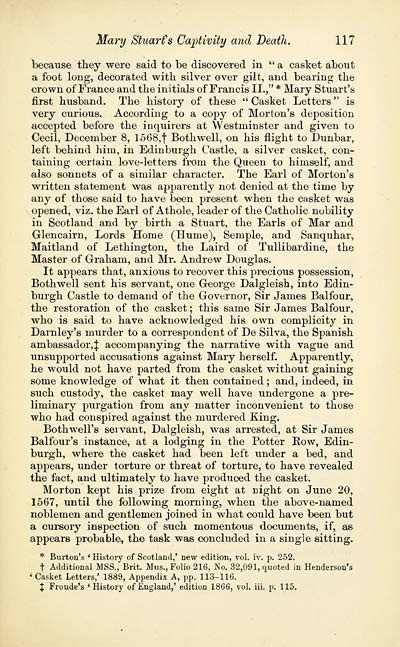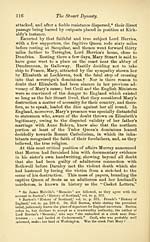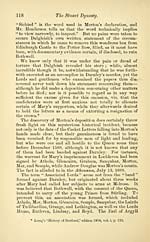Stuart dynasty
(137) Page 117
Download files
Complete book:
Individual page:
Thumbnail gallery: Grid view | List view

Mary Stuarts Captivity and Death. 117
because they were said to be discovered in " a casket about
a foot long, decorated with silver over gilt, and bearing the
crown of France and the initials of Francis II.," * Mary Stuart's
first husband. The history of these " Casket Letters " is
very curious. According to a copy of Morton's deposition
accepted before the inquirers at Westminster and given to
Cecil, December 8, 1568,f Bothwell, on his flight to Dunbar,
left behind him, in Edinburgh Castle, a silver casket, con-
taining certain love-letters from the Queen to himself, and
also sonnets of a similar character. The Earl of Morton's
written statement was apparently not denied at the time by
any of those said to have been present when the casket was
opened, viz. the Earl of Athole, leader of the Catholic nobility
in Scotland and by birth a Stuart, the Earls of Mar and
Glencairn, Lords Home (Hume), Semple, and Sanquhar,
Maitland of Lethington, the Laird of Tullibardine, the
Master of Graham, and Mr. Andrew Douglas.
It appears that, anxious to recover this precious possession,
Bothwell sent his servant, one George Dalgleish, into Edin-
burgh Castle to demand of the Governor, Sir James Balfour,
the restoration of the casket ; this same Sir James Balfour,
who is said to have acknowledged his own complicity in
Darnley's murder to a correspondent of De Silva, the Spanish
ambassador,:): accompanying the narrative with vague and
unsupported accusations against Mary herself. Apparently,
he would not have parted from the casket without gaining
some knowledge of what it then contained ; and, indeed, in
such custody, the casket may well have undergone a pre-
liminary purgation from any matter inconvenient to those
who had conspired against the murdered King.
Bothwell's servant, Dalgleish, was arrested, at Sir James
Balfour's instance, at a lodging in the Potter Bow, Edin-
burgh, where the casket had been left under a bed, and
appears, under torture or threat of torture, to have revealed
the fact, and ultimately to have produced the casket.
Morton kept his prize from eight at night on June 20,
1567, until the following morning, when the above-named
noblemen and gentlemen joined in what could have been but
a cursory inspection of such momentous documents, if, as
appears probable, the task was concluded in a single sitting.
* Burton's ' History of Scotland,' new edition, vol. iv. p. 252.
t Additional MSS., Brit. Mus., Folio 216, No. 32,091, quoted in Henderson's
' Casket Letters,' 1889, Appendix A, pp. 113-116.
J Froude's 'History of England,' edition 1866, vol. iii. p. 115.
because they were said to be discovered in " a casket about
a foot long, decorated with silver over gilt, and bearing the
crown of France and the initials of Francis II.," * Mary Stuart's
first husband. The history of these " Casket Letters " is
very curious. According to a copy of Morton's deposition
accepted before the inquirers at Westminster and given to
Cecil, December 8, 1568,f Bothwell, on his flight to Dunbar,
left behind him, in Edinburgh Castle, a silver casket, con-
taining certain love-letters from the Queen to himself, and
also sonnets of a similar character. The Earl of Morton's
written statement was apparently not denied at the time by
any of those said to have been present when the casket was
opened, viz. the Earl of Athole, leader of the Catholic nobility
in Scotland and by birth a Stuart, the Earls of Mar and
Glencairn, Lords Home (Hume), Semple, and Sanquhar,
Maitland of Lethington, the Laird of Tullibardine, the
Master of Graham, and Mr. Andrew Douglas.
It appears that, anxious to recover this precious possession,
Bothwell sent his servant, one George Dalgleish, into Edin-
burgh Castle to demand of the Governor, Sir James Balfour,
the restoration of the casket ; this same Sir James Balfour,
who is said to have acknowledged his own complicity in
Darnley's murder to a correspondent of De Silva, the Spanish
ambassador,:): accompanying the narrative with vague and
unsupported accusations against Mary herself. Apparently,
he would not have parted from the casket without gaining
some knowledge of what it then contained ; and, indeed, in
such custody, the casket may well have undergone a pre-
liminary purgation from any matter inconvenient to those
who had conspired against the murdered King.
Bothwell's servant, Dalgleish, was arrested, at Sir James
Balfour's instance, at a lodging in the Potter Bow, Edin-
burgh, where the casket had been left under a bed, and
appears, under torture or threat of torture, to have revealed
the fact, and ultimately to have produced the casket.
Morton kept his prize from eight at night on June 20,
1567, until the following morning, when the above-named
noblemen and gentlemen joined in what could have been but
a cursory inspection of such momentous documents, if, as
appears probable, the task was concluded in a single sitting.
* Burton's ' History of Scotland,' new edition, vol. iv. p. 252.
t Additional MSS., Brit. Mus., Folio 216, No. 32,091, quoted in Henderson's
' Casket Letters,' 1889, Appendix A, pp. 113-116.
J Froude's 'History of England,' edition 1866, vol. iii. p. 115.
Set display mode to:
![]() Universal Viewer |
Universal Viewer | ![]() Mirador |
Large image | Transcription
Mirador |
Large image | Transcription
Images and transcriptions on this page, including medium image downloads, may be used under the Creative Commons Attribution 4.0 International Licence unless otherwise stated. ![]()
| Histories of Scottish families > Stuart dynasty > (137) Page 117 |
|---|
| Permanent URL | https://digital.nls.uk/94819410 |
|---|
| Description | A selection of almost 400 printed items relating to the history of Scottish families, mostly dating from the 19th and early 20th centuries. Includes memoirs, genealogies and clan histories, with a few produced by emigrant families. The earliest family history goes back to AD 916. |
|---|

